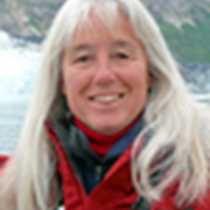Sand Bay & Tracy Arm
This morning the National Geographic Sea Bird anchored in Sand Bay, situated on the mainland on the east side of Stephens Passage. With our breakfast and informational briefings complete, we donned gear to go ashore for hiking or kayaking. Salmon pooled at the mouth of a stream, readjusting to fresh water and waiting for a higher tide to help push them toward their spawning beds.
Bear tracks were left in the mud and their droppings were left in the forest – tell-tale signs of unseen activity. The fish link the ocean to the forest through the bears, eagles, and other creatures that feast on this annual bounty and leave the nutrients to feed the trees and the next generation of salmon.
A pair of belted kingfishers sought tiny fish fry along the banks of the stream. A bright patch of fuchsia-colored fireweed interrupted the many shades of green at the forest edge. Groups of surf scoter sea ducks and curious seals were the companions of the kayakers. Sunshine beamed down on us by the time we returned to the ship.
We entered Holkham Bay and Tracy Arm just to the north of Sand Bay. This is part of a vast and pristine wilderness untrammeled by people. We wound our way back in time through the twists and turns of this classic fjord – over 1200 feet deep and less than a mile wide in places. Great walls of granitic rock rise precipitously from the water’s surface. Yosemite-like features convinced John Muir that glaciers did indeed sculpt such landscapes.
Two tidewater glaciers tumble down from the mountains to the sea at the split ends of Tracy Arm. We visited South Sawyer Glacier by Zodiac, approaching to the edge of a dense sea of icebergs on which there were resting harbor seals. A few weeks earlier the seals had used the icebergs as birthing platforms, protected from terrestrial and marine predators. We were awed and thrilled by the experience of “white thunder,” when tons of ice fell from the glacier’s face and crashed into the water with a tremendous splash and a resounding roar. Late afternoon light played nicely on the blue and white face of the glacier, providing numerous photographic opportunities.
Meanwhile, two National Forest Wilderness Rangers paddled up to our ship by kayak. Sean and Jenny came on board and spoke to us about their life as rangers and what they do to help protect this area. They educate visitors, monitor ship emissions, pick up garbage, assist in seal research, pull exotic weeds, and many other projects. Questions and conversation continued with them through dinner as we transported them back down the bay and dropped them near their base camp on Harbor Island and they paddled off into the sunset.




